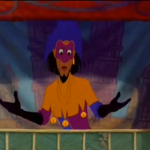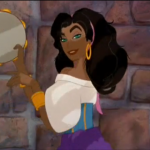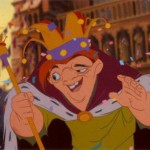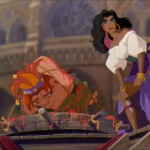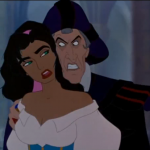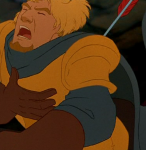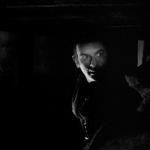Hey Hunchback fans, I’m working on the next character review (except it soon ^^) but I have made more Squidoo lenses on Hunchback (hooray). I have lenses on art, music, and a personality quiz ^^. So yeah, check them out ^^
Read More →The Disney version starts off with Clopin (Paul Kandel) regaling small children with the tale of the mysterious bell ringer and how he came the position. Though a song (The Bells of Notre Dame) and a flashback Clopin tells of a group of Gypsies entering Paris via the Seine, the notable Gypsy is a women with a child. After docking the Gypsies are caught by Judge Claude Frollo (Tony Jay). Frollo doesn’t care much for gypsies and orders their arrest but when he tries to take the baby from the women (he thinks it stolen goods) she runs toward Notre Dame. After the chase Frollo kills the women on the steps of Notre Dame and Frollo tries to drown the child who is deformed. Before Frollo can do it he’s stop by the Archdeacon (David Ogden Stiers) who guilts Frollo into taking care of child but Frollo demands that the child must live in the bell-tower. Clopin then asks us to consider what the bells supposedly say “who is the monster and who is the man”
After a lovely crescendo and the title screen featuring those crazy bells we’re introduced to Quasimodo (Tom Hulce) who is urging a baby bird to fly away as no one wants to be cooped up in Notre Dame forever. After the bird flies away Quasimodo’s gargoyles friends come to life. Victor (Charles Kimbrough), Hugo (Jason Alexander), and Laverne (Mary Wickes(and Jane Withers)). The three urge Quasimodo to go the Festival of Fools but Quasimodo says he forbidden to ever leave the cathedral by his master Frollo. After some a little encouragement he decides to go but Frollo shows up and tries to persuades him out of ever leaving because of his ugliness he’ll only meet with hate. Frollo does with via song (Out There). After Frollo is done singing and leaves Quasimodo takes over the song (Out There), and sings about a desire to have one day out among normal people.
The scene switches to Phoebus (Kevin Klein), Captain of the Guard, returning to Paris. He catches the eye of pretty Gypsy girl, Esmeralda (Demi Moore), dancing for coins. After some other guards show up and accosted Esmeralda for stealing, Phoebus aids in her escape. Phoebus then makes the trouble-making, underling guards guide him to the Palace of Justice. He meets Frollo who explains that Paris must be rid of the Gypsies as they weaken the moral of the otherwise good Parisian and then they head out to the Festival of Fools.
The Festival begins as a clocked Quasimodo swing down from Notre Dame and gets caught up in the festivity of the party as Clopin serves as the master of ceremonies by singing Topsy Turvy . While Quasimodo is getting thrown about he crashes into a tent where Esmeralda is changing. She asks Quasimodo if he is injured and compliments his mask, Quasimodo is instantly smitten with her. Frollo, Phoebus, and guards arrive on the scene and Esmerlada dances for crowd and gets the attention of Quasimodo, Frollo and Phoebus. After that the King of Fools contest starts, as the ugly masses came on to the stage, Esmeralda pulls Quasimodo up on stage. Once it is reveal that Quasimodo “mask” is really his face he is crowned king of fools, much to Frollo’s disapproval.
After the song ends, the underling guards, throws a tomato at Quasimodo causing the crowd to pelt him with foodstuff and tie him down to the pillory. Phoebus wants to intervene but Frollo insists Quasimodo is learning a lesson. The barrage of food ceases when Esmeralda ascends the pillory, and apologizes to Quasimodo. Frollo orders her down and not to help. After a quip about justice and mistreat of people (especially her people) she free Quasimodo. Frollo orders her arrest and a merry chase ensues.
After Esmerlada gives everyone the sip, Quasimodo apologizes to Frollo and returns to Notre dame. Phoebus sees an old man wander into Notre Dame and follows. The old man is Esmerlada who has chosen Notre Dame as hiding place. She senses a presence behind her (Phoebus) and she engages him in combat. As she fights, he flirts, which after a bit works but Frollo interferes demanding her arrest. Phoebus claims she claim sanctuary and he can’t do anything. Frollo demand that she be dragged out side but the good-old Archdeacon commands that Frollo can’t do anything. As Phoebus and the other guards leave, Frollo hides and grabs Esmeralda from the back and says he’ll wait for her to leave and then continues to grope her. He leaves and Esmeralda learns that guards are position all around the cathedral. Esmeralda sings a prayer for not just her people but for all outcast (Good help the Outcast {sung by Heidi Mollenhauer). As she sings Quasimodo hears it and follow it. When the song ends Quasimodo is told off and flee back up to the bell tower, as he flees Esmeralda pursues.
The two becomes friends and learn more about each and how Frollo can be wrong about people. Quasimodo then decide to help Esmeralda escape but climbing down the building. Esmeralda ask Quasimodo to comes with her to The Court of Miracles (the Gypsy haven), but he refuses and she gives him a woven band to help if he needs sanctuary. Quasimodo returns to the tower and his gargoyle tease him about having a girlfriend. He sings a song about his feelings for Esmeralda and hope for love (Heaven’s light). Meanwhile, Frollo is also singing about his lust and obsession for Esmeralda (Hellfire). During the course of the song he learns that Esmeralda has escaped.
The next day, Frollo has order the capture of Esmeralda. He uses force, bribes, and attempted manslaughter. Frollo tries to kill an entire family for harboring Gypsies, he orders Phoebus to burn the house where the family is trap but Phoebus refuses and sentence to death, but a disguised Esmeralda intervenes via rock. Phoebus gets away but is shoot by an arrow and falls into river. Esmeralda saves him.
Meanwhile, Frollo has set Paris ablaze. Quasimodo is worried about Esmeralda’s safety but the Gargoyle assure him that she’s fine and she’ll return to Quasimodo and convinces him that she is in love with (A Guy like you). The song ends with Esmeralda entering the tower and asks Quasimodo to hide Phoebus. As Esmeralda tends to Phoebus‘ wound it became clear that she not into Quasimodo in the romantic sense. Quasimodo hears Frollo coming and Quasimodo tries to cover. Frollo reveals that he knows where the Court of Miracles is and is going to attack. Quasimodo and Phoebus set out to warn the Gypsies. Quasimodo relies that the woven band is a map and they find the Court of Miracles. The pair is ambush by Clopin (Court of Miracles), since the Court of Miracles doesn’t like uninvited guest they going to hang them, but Esmeralda stops them. Phoebus warns them about the attack but Frollo followed them and arrest everyone.
As Frollo prepare to execute Esmeralda, he asks her to chose him or the fire, she choses the later and the pyre is set aflame. Quasimodo then swings down from Notre Dame frees Esmeralda swing back up and yells sanctuary. Frollo the attacks Notre Dame and Quasimodo defends. Everyone get in on the battle, Phoebus, Clopin, the gargoyles, random extra and birds. Quasimodo uses molten lead but Frollo sneaks in.
Quasimodo tells Esmeralda to come see his victory but it seems like she dies of asphyxiation. Quasimodo cries as Frollo slips into the room and tries to kill him but Quasimodo fights back and Esmeralda regains consciences, and Frollo goes on murderous offense. After a bit of fight Frollo is about to win as Esmeralda clings to Quasimodo who is dangling over the edge of Notre Dame but Frollo support gives out and he falls to his death. Esmerlada strength gives out and Quasimodo falls but he caught by Phoebus. Quasimodo then gives the couple his blessing. Esmeralda and Phoebus emerge from the cathedral and are met with cheers. Esmeralda offers Quasimodo her hand and leads him outside where he is finally accepted by the people. Clopin reprise “The Bells of Notre Dame” and asks us “what makes a monster and what makes a man”.
Next time – A Plot Review of Disney’s Hunchback of Notre Dame
So how does the 1939 version of “The Hunchback of Notre Dame” hold up against Victor Hugo’s novel? Well first let’s identify some MAJOR differences.
The First difference is Frollo. Hugo’s Frollo has been spilt into two characters. This was not the first film and certainly not the last film to do this, but to my knowledge it was the first to make him a High Justice and the last to separate him between brothers. If you haven’t read the book, Frollo has a younger brother name Jehan. Jehan is quite licentious while Claude, the older Archdeacon, is the lusty priest. So splitting the Frollo character into brothers isn’t a stretch. The reason why Frollo is spilt into the pious brother and lusty bad younger brother is the same reason why Quasimodo is crowned the “King of Fools” and not the “Pope of Fools”; The Hays Movie Code. The Movie Code (Censorship) that was in affect back in the 30s didn’t allow the church to look bad in any fashion (among other things). I give the film some credit, it tries to remind the viewer that Frollo should be a priest, or at least he wants to be a priest.
ESMERALDA: Who are you? You’re not a priest, and yet you look like one. FROLLO: I am what I wish to be.
Though him being a priest wanna-be doesn’t make me believe in his torment of “wanting” Esmeralda. Fortunately he doesn’t seem to combat his emotions, he goes from “I want you” to “you must die” in record time and doesn’t think twice. Whereas Hugo’s Frollo runs the gambit of emotions for Esmeralda. Plus it’s not important that he is in deep torment because the film is not really concerned with Frollo, Frollo is a necessary character because he is the catalyst for the story. Without Frollo, the book would have ended with Feast of Fools, the adaptations need him as a character but the lengths of his development are left to film. The ‘39′ Frollo gets some development but not enough. Instead characters that are lesser in significance get push to the forefront due to the next major difference of the movie.
The next big difference is modernity and the conflict between old vs new. The book did have a rather long chapter/essay called “This will Destroy that”(translations may vary) which was about how books will destroy the church and architecture. So instead of the cathedral being the conduit to teach the masses the stories and the history of the christendom, books would take over that role. But the film pushes this way too far and distracts from the main plot, hell the film opens with a scene that rehashes “This will destroy that” just with a positive spin. Also because the film takes a modernity good-old fashion bad, Gringoire, Clopin, and King Louis are made into more prominent characters despite being lesser characters in book especially Louis, whose hardly a character at all.
But these are not the only character that are tweaked. Esmeralda is very different than in the book. In the book she is a naive, innocent, flighty, and pone to giving into whims. She also had a very different back story, a back story that seldom gets into adaptations. The only part of her backstory that can be compared to the book is that she came to Paris on the Feast of Fools in the movie, and in the book she had been in Paris a for over a year and was beloved amongst the people of Paris. In the movie, her motivation is for her people and she has a strong sense of empathy instead of love of dancing. It is interesting to note that when Esmeralda has these characteristic, Frollo is a High Justice who seems to hold more power than the king (in the 39 movie, he rounds up all the Gypsy girls in the Court of Miracles and the Disney he burns all of Paris). I suppose the caring, empathic Esmeralda is a counterpoint to the powerful, racist Frollo, but it’s a striking difference to her character in the book where she is a naive, simple, winsome child, who is unaware of her own charms. The 1939 characterization of Esmeralda she isn’t naive and she does at least in the 39 version, use girlish charms to get Louis to help her. She’s not above turning on the charms to get what she wants but doesn’t do it with Frollo, perhaps she didn’t know Frollo was in a position that could have help her. At least in the book she was afraid of him, hence she didn’t want to have anything to with him. In the 1939 version she doesn’t seem to exhibit any strong feelings towards, she neither likes him nor hates him, but she strikes an accord with him about animals. So I guess she could have turned up the feminine charms towards Frollo had he not been a bigoted pervert. The main reason why Esmeralda is never depicted as she is in the book, is she would come off unlikable, (a shallow, simple, young girl) so the film always has to tweak her character to make her likable. If she cozen up to Frollo, the villain, she wouldn’t have been as likable and has the only main female character, she has to likable.
Hello and Welcome to the Hunchblog of Notre Dame.
This Blog is dedicated to reviewing and analyzing the different adaptations of Victor’s Hugo novel Notre Dame de Paris aka The Hunchback of Notre Dame. There are dozens of retelling of the novel ranging from movies, cartoons, musicals, ballets, and operas. Some are considered masterpieces and some are just pain awful. Some are vastly popular and beloved and even more are unknown.
So why review the various adaptations of this particular novel? It’s a story that is known throughout the world but at the same time it’s misunderstood. This is mainly because the focus has shifted from “Our Lady of Paris”(Esmeralda) to Quasimodo as the main (titular) character. Of course not all the versions put Quasimodo as the main character but more than enough have. Is it a bad thing not to follow the novel faithfully? Should failure to follow the novel at least somewhat means that the version be diminish in the quality of the version? I would say no, even if I’m somewhat of purist on following the source material. But so for the sake of this blog, I’m going to review the adaptation on their own merits and then look at the version against the novel.
So stay tuned ^__^

